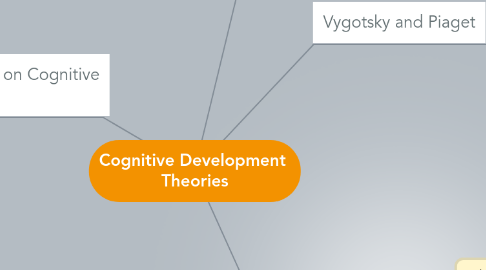
1. Abby's Thoughts on Cognitive Development
1.1. Cognitive development and its theories provide educators and parents with a baseline for understanding the thinking and reasoning milestones children reach and when. While there is no foolproof checklist and all children are different, cognitive development theories provide an guide to judge the mental growth of children.
2. Jean Piaget
2.1. "Children are active and motivated learners (Ormrod, 2014, p. 26)." Piaget believed that since the world is so new to young children they were intrinsically motivated to learn new things using all their senses (26). While children can be guided to areas of interest, they should be in control of their experiences rather than lead.
2.1.1. Application for Today: This line of thinking is similar to the student-centered teachings of Maria Montessori, who encouraged educators to structure learning environments to the students' interests and be a guide rather than an authority (Barone, 2010). Teaching using Montessori methods are still popular today as parents prefer a more tailored approach to education rather than "one-size-fits-all."
2.1.2. Activity: In a traditional public school, it could be difficult to provide such a free-spirited view of lessons. It might be a better fit to provide centers for students as an outlet for their academic interests. Once a week have class time devoted to centers with a new subject each week and provide different topics at each center. For example, during science week, one center could be dinosaur themed, one could be space, one could be flowers and plants, and one could be the ocean. Students could pick what center they wanted to participate in.
2.2. "The process of equilibriation promotes progression toward increasingly complex thought (Ormrod, 2014, p. 27)." Piaget believed that children learn when their interpretation of stimuli in their environment is challenged (27-28). For example, if all modes of transportation with two wheels and a motor are motorcycles, they are in a state of disequilibrium (28) when they see a motorcycle with three wheels. To reconcile the new information, they must change their understanding of what a motorcycle is and what it can be.
2.2.1. Application for Today: With so many outlets to expose students to new things, it can potentially be difficult to cause the state of disequilibrium (Ormond, 2014, p. 28) in older children. Maybe students will not be as surprised to see a three wheeled motorcycle, but more abstract thinking could provide the stimulus for new understanding.
2.2.2. Activity: Have students write down characteristics of a particular fairy tale. For example, what themes make up the story of Cinderella? Then, have them read three versions of Cinderella stories from different cultures or different time periods. Have them compare and contrast these stories with the one they grew up with. Then have them write or discuss what are the common elements or themes that generalize the story of Cinderella.
3. Lev Vygotsky
3.1. "Through both informal conversations and formal schooling, adults convey to children the ways in which their culture interprets and responds to the world (Ormrod, 2014, p. 37)." Children are greatly influenced by the society and culture they are brought up in. Ideas highly valued in one area of the country might not make it into the curriculum in another area.
3.1.1. Application for Today: Students from different parts of the world, or even in different parts of the country have different learning experiences which shape their interests and their intellect. Students whose families value education and push them to be their academic best will have a different experience in school than students whose families do not. Additionally, students in New York City with access to large art museums and pop-up independent galleries will have a different perspective of and exposure to art than students in smaller towns who have to travel to larger cities to visit an art museum.
3.1.2. Activity: Provide students the opportunity to virtually access information they might not have the ability to in person. Or, invite guest speakers in to talk about interesting places or ideas to provide a human aspect to the topic. For example, work with teachers in the high school for their students to create and teach a language lesson. Invite a local artist to share his/her art pieces and to speak about the creation process.
3.2. "Play allows children to stretch themselves cognitively (Ormrod, 2014, p. 39)." Play time allows children to act out roles and interpret cultural norms and expectations in a safe environment. Play also allows children the ability to work through conflicts and interact socially with their peers, which will help in social situations as they age.
3.2.1. Application for Today: Though there is a push to bring it back, recess in elementary schools has been on the decline. Free-play time has been reduced or removed completely. Even structured physical education has taken a back seat. It is important to remember that recess provides just as many opportunities for learning as it provides opportunities to expel energy. Time for play, whether structured or free, should become a priority.
3.2.2. Activity: Divide students into groups and provide them with a prop, a setting, and a word they must incorporate, and allow them to create a three minute play for their classmates. All the settings will be the same but the prop and the word are different. How the students structure their plays will vary based on their experiences and interests. Even though the settings are the same, the prop and the word can change the outcome of the play. Then the students should compare and contrast the plays.
